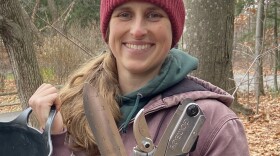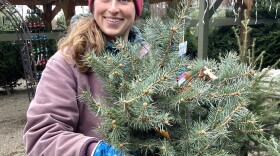All plants have specific growing conditions that allow them to thrive, including adequate sun exposure, ideal temperatures, sufficient water, and preferred soil quality.
“Weeds have those requirements too,” says Emma Erler, host of Homegrown NH and lead horticulturist at Kirkwood Gardens at Squam Lakes Natural Science Center.
“By looking at which weeds are thriving in your yard or garden, you can get some insight into the growing conditions.”
Erler says many people in New Hampshire have very acidic, well-drained soil with insufficient levels of nutrients and poor soil structure.
If you have these conditions, you're likely to see weeds like red sorrel or hawkweed. Hawkweed resembles a small dandelion with furry leaves, and it will completely take over a garden or a lawn.

In areas that have good quality loam, with some good organic matter, you see weeds like Creeping Charlie, also called ground ivy or wood sorrel. You might also have common groundsel, which can grow up to 3 feet tall. If you have good soil, this may be what's taking over your beds.
Before she plants anything, Erler looks at the weeds growing in that area to get an idea of what the soil might be like.
“If I see something like red sorrel taking over, I know that the soil is probably very well drained, has very little nutrients, and is probably pretty acidic," she says.
"That tells me I'm probably going to need to do some amending to make sure other plants are going to grow well in that spot. Or if I don't want to do that, I need to choose plants that prefer well-drained soil with low fertility.”

The easiest way to identify which weeds are growing in your yard or garden is to take a photo and compare it to images online.
“I tend to be a little bit more old school,” says Erler. “I have a great book called Weeds of the Northeast, which covers pretty much every weed you're going to find growing in your garden in New Hampshire.”
Weeds are not necessarily just something to get rid of, and the definition of a weed is up to you.
“You may decide some plants are not actually weeds, if you like the way they look,” says Erler. “If it's something you don't want growing in a particular spot, then that's a weed.”
There are many examples of common weeds that may be worth tolerating.
Some people consider violets to be nuisance weeds, but according to Erler, they are host plants for butterflies like fritillary that need them to complete their life cycle.
“Dandelions are a wonderful plant for pollinators early in the season, although they can totally take over a lawn or garden area if you let them, says Erler. “I often let them bloom, but try to dig them up before they go to seed.”
See you in the garden!
Homegrown New Hampshire is a collaboration between Squam Lakes Natural Science Center and NHPR.










